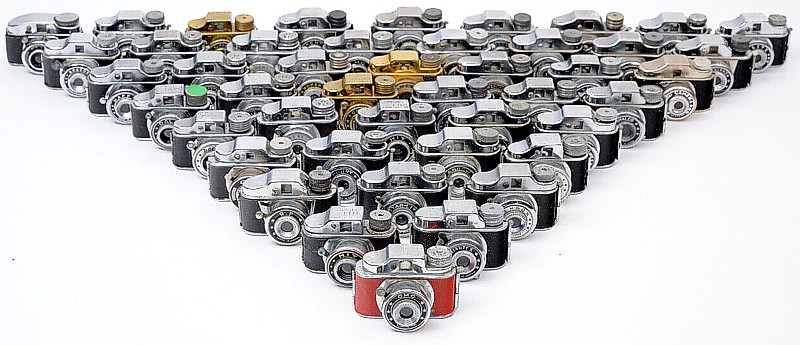
17.5MM CAMERAS

When shooting film in a motion picture (AKA, Movie) camera, cost is always a concern, as film flies through the camera at an incredible rate. Not surprising, the early 17.5mm format started out as an inexpensive alternative to 35mm motion -- 35mm film was just split in two. The 17.5mm motion picture format was known in France well before World War II and was called "Pathe Rural". Pathe Rural was intended for rural areas, with no permanent theater, and was more economical than regular 35 mm. It was not long before still cameras were designed to use the readily available 35mm and 17.5mm motion picture films.
The best known 17.5mm still-picture camera is the "HIT" camera, from Japan. The term "HIT" has come to mean any camera with features similar to this original model -- even if made by another manufacturer. The definition of a HIT camera is generally a simple camera with:
But there are many cameras that come close to this definition, so what is and isn't a "HIT" varies from person to person. Would a camera that meets all of these criteria, but uses 16mm film quality as a HIT? Or how about a camera with two shutter speeds? Or one with a variable aperture?
HIT cameras were definitely a hit when they appeared on the Japanese market just after the end of World War II. The reason they were designed, and the reason for their popularity, was that cameras, film and processing -- in short, photography -- were horribly expensive in Japan after the Second World War -- in a country that LOVED photography. Most of their cities had been largely destroyed during the War, and just getting enough food was an enormous challenge and expense. The features and quality of these cameras was not great -- the U.S. market considered them toys -- but they sold well in Japan since they were inexpensive.
Most 17.5mm cameras use paper-backed, split, unperforated, 35mm film, keeping costs down. Most are also very simple mechanically and, today, are mainly collected, as opposed to used for their picture quality. Most, but not all, created 14x14mm images. While most of these cameras were poor performers, a few produced excellent results with good optics and adjustable features!
Just to muddy the photographic waters, these 17.5mm cameras are also sometimes called Mycro (or Micro) or Midget cameras after other common nameplates. The film and format are sometimes called Mycro, as well. Keep in mind that, not all 17.5mm cameras are HIT-type cameras, and not all HIT-type cameras use 17.5mm film. Some additional "HIT"-style cameras that used 16mm film are listed under the 16mm camera section. There were even a few camera models that could use 16mm or 17.5mm film.
Even though this list is long, it has inaccuracies, and incomplete. Much of the information about any particular camera, especially rare cameras, is virtually impossible to find. Sometimes all that is available is very limited information, a photograph of the camera, or a listing in a catalog -- often with mis-spellings! Others were only prototypes, and never made it to the marketplace. As a result, details about any camera may be incorrect. To complicate matters, many cameras changed over time, and were available in different styles, with different features -- and different coverings & colors.
If you are able to provide more accurate information than is listed here, please contact us.
-- a "HIT"-type camera. Two speeds, I (1/50) and B.
-- a "HIT"-type camera that is possibly a mis-listing of the Atomy (see below). There have been many cameras, and lenses, throughout history that have been mislabeled, such as the Konica EYE, often being listed as the Konica CYC, or the Fujifilm RECTAR lenses being listed as RECSAR. If the Alome does exist, it is a rare bird indeed.
-- an early "HIT"-type camera from Tougodo. We know it's early because it is often marked "Made in Occupied Japan".
-- It's just a basic "HIT"-type camera, but often listed as "Arcoflex" or "Arco-flex".
-- a "HIT"-type camera -- and a very common one at that! It was made by at least two Japanese manfacturers, is very common, and has several body-style variations. However, it should not to be confused with the Arrow-Camera (below), although some Arrow models have a body style very similar to that of the Arrow-Camera.
-- also a common "HIT"-type camera. This one is not the same as the Arrow (above) although it is very similar. It was made in Hong Kong, not Japan, and is marked "ARROW-CAMERA" on the front plate.
-- a "HIT"-type camera, not to be confused with the Astropic (below) or the Astrocam (by Estes).
-- a "HIT"-type camera, made by Tougodo -- not to be confused with the Astra (above) or the Astrocam (by Estes).
-- Probably just a misspelling of Atomy (below), but it does appear on some Hit lists. If it does exist, the Atoms is a rare bird indeed.
-- This is a very early, post-war "HIT"-type camera, and consequently is often marked "Made in Occupied Japan" -- but it's not often seen at all. It sports a 20mm lens, and has been seen -- like other Hit-type cameras -- with slightly different film advance knobs, and top cover plates. It's possible that it has been occationally mis-listed as the Alome (see above).
-- see Colon
-- (1950) This is a tiny twin lens reflex (TLR) camera with a pop-up viewfinder. It produced 14x14mm images, but it's not a quality shooter -- at least not the original model. It has a Sanko 20mm f3.5 lens, but the Peace shutter evolved over time -- starting with simple I & B settings to a version with speeds of B, 1/25 - 1/150. It later became the similar Peace Baby Flex (see below). To complicate matters further, it should not be confused with the much larger Baby Flex, a TLR made by Kinax -- using 120 film. Got all that straight?
-- This likely non-existent camera is probably just a mis-spelling or confusion with the Baby Flex, Baby-Max or Barlux cameras (below) -- similar to the confusion of the Atomy, Atoms, and Alome cameras (above).
-- (1960) Made by Tougodo, the Baby-Max qualifies as a "HIT"-type camera with a non-focusing, somewhat long 30mm (fixed f11.0) lens and a single shutter speed. However, it has a different body style and top plate from the traditional Hit camera, and is noticeably wider. It was also sold as the Barlux (below).
-- a "HIT"-type camera made by -- you guessed it -- Tougodo!
-- Made by Tougodo, the Barlux is a "HIT"-type camera in most respects. It has a fixed-focus lens and a single speed, but it has an unusual shape for a Hit-type camera. It was also sold as the Baby-Max (above).
-- Despite it's name, it's just a typical "HIT"-type camera, made by -- you guessed it -- Tougodo! Most are marked Beica on the lens and the top, but true to Tougodo's infamous quality control, a few of these cameras are marked "HIT" on the lens and "Beica" on the top -- see C.M.C (below).
-- (1960) The features were similar to "Hit"-type cameras, but the appearance was more like a tiny rangefinder camera. Fixed-focus lens with a fixed aperture. Single shutter speed. Attractive leatherette covering. Not to be confused with the other Bell cameras that used 16mm film.
-- a typical "HIT"-type camera, but marked "Made in Japan" on the lens front plate.
-- a "HIT"-type camera
-- a "HIT"-type camera
-- a "HIT"-type camera
-- a "HIT"-type camera. It's a common model, and was made by Tougodo, the originator of the real Hit camera (see details below). Like many other Hit-type cameras, it was produced with several colored leatherettes -- blue, red, green, yellow, brown, turquoise, and black. Collect them all.
-- (1960) Fixed-focus 30mm, fixed f11 lens. Single speed of 1/30. A "HIT"-type camera made by -- you guessed it -- Tougodo, which appeared, like other "Hit"-type cameras, with several slight differences over time.
-- although showing up on "HIT"-type camera lists, it's really just the Click camera (above). The confusion is created because the box it came in is marked "Click Camera". Similar confusion exists with other 17.5mm cameras such as the Sing 888 & Sing 388 and Mini cameras (see below) due to the camera and the box having different "names".
-- sometimes listed, but it's probably just a incorrect spelling of C.M.C. -- like the Konica EYE 35mm half-frame being incorrectly listed as the Konica CYC because the E's look like C's.
-- a "HIT"-type camera. Very common, and not to be confused with the C.M.C CAMERA -- below -- even though they were made by the same manufacturer -- Tougodo Corp. (see HIT and TOUGODO, below). It is marked "CMC" on the top of the lens, but is marked "MADE IN JAPAN" on the bottom. Two speeds, I (1/50) and B. It came in a variety of body and leatherette colors.

There are even some rare, "misprinted" Tougodo "Hit" cameras, such as this C.M.C. that has the C.M.C. label on the lens, but is stamped "HIT CAMERA" on the top -- proving they were made in the same factory. See Beica, above.
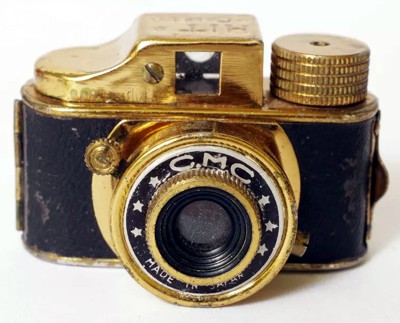
-- a "HIT"-type camera. Very common, and not to be confused with the C.M.C camera -- above -- even though they are the same, and both made by Tougodo. It is marked "CMC" on the top of the lens, and marked "CAMERA" on the bottom, instead of "Made in Japan". I know -- who cares? A whole separate listing just because of that small difference?. Remember, we're talking about "collectors"! Any small difference is important. Like the "plain" C.M.C, it came in a variety of body and leatherette colors -- but each of these is not listed separately.
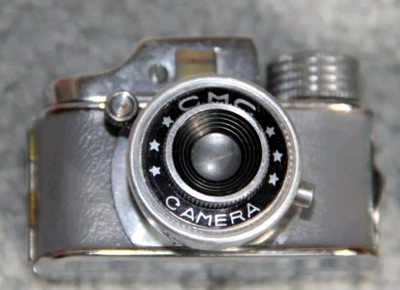
-- (1960) Fixed-focus 30mm (fixed f11.0) lens. Single speed of 1/30. A "HIT"-type camera made by -- you guessed it -- Tougodo!
-- (1950) Like the Jenic (below), the Colon was vertically-styled, like a movie camera -- but it was a simpler camera than the Jenic. It has a fixed-focus f7.0 lens and a viewfinder on top. Speeds of B and I. A film winding lever is on the side. Although the box is labeled "Baby Colon", the camera is only maked "Colon". This discrepany occurs with many 17.5mm cameras -- as well as with some 16mm, DISC, and 110 cameras, too!
-- a "HIT"-type camera
-- a better than average Hit-type camera withe a dual viewing system -- eye-level and waist-level.
-- a "HIT"-type camera
-- a "HIT"-type camera
-- a "HIT"-type camera
-- a "HIT"-type camera
See Laurie Import -- below.
-- a "HIT"-type camera from the late 1960s made by Tougodo with a 28mm fixed-focus f11 lens and a shutter speed of 1/50.
-- a "HIT"-type camera
-- a "HIT"-type camera, and seen with slightly different face-plates, and slightly different film knobs.
-- a "HIT"-type camera made by -- you guessed it -- Tougodo! Not very common, and appeared in at least one color other than black.
-- a "HIT"-type camera. If you can decode the meaning of the name, you win a prize! Here's a clue -- "TC" is short for "Tiny Camera".
-- The first of four cameras from the Taiyo-do Optical Works in 1948 -- followed by the similarly-styled Beauty 14, Vestkam, and Meteor cameras in 1949. Although these four camera were very simple, and used 17.5mm, paper-backed roll film, many do not consider them true "HIT" cameras because of their body styling and features. The Epochs has a 20mm f3.5, fixed-focus, fixed aperture lens, and shutter speeds of B, 1/25 and 1/50.
-- see Hit Foreign, Minetta Foreign & Marvel Foreign
-- a typical "HIT"-type camera
-- a "HIT"-type camera. Not made by Fuji Photo Film Co., Ltd. (now Fujifilm), but by Fuji Kogaku Seiki Company. There were two cameras with the same name, or more appropriately, the Fuji camera appeared in two versions. Both models had the same features, and an inscribed silhouette of Mt. Fuji on the top of the camera. The first model was similar to many Hit-style cameras and came in a chrome body with black leatherette.
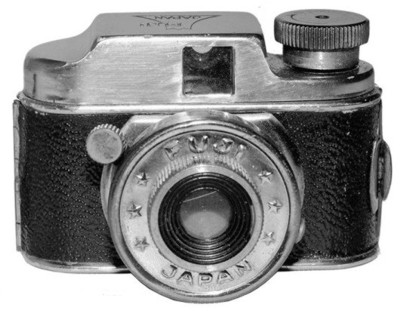
The later, easier-to-find, model only came in a gold finish with a body style a little closer to the Comex (above) and the Nikkobaby (below) cameras that they also produced..

-- one of the earliest 17.5mm cameras -- late 1940's -- the Gamma is shaped more like a tiny 35mm rangefinder than a typical "HIT"-type camera. It is larger than the typical HIT, but not by much. The shutter release is on the camera top, not the lens -- which is a rather long, focusing, Angel 20mm f4.5 optic with f-stops to f9. Three speeds of 1/50, 1/25, and B. The accessories include the usual camera case, lens shade, and HUGE flash bulb holder that clamps onto the lens -- very similar in appearance to the flash for the Mamiya 16 series of cameras. It is marked "MADE IN OCCUPIED JAPAN".
see Morita Gem 16
-- (1950) Fixed-focus lens. Single speed. A "HIT"-type camera
-- (1962) Fixed-focus lens. A lighter-type camera, not a Hit-type camera. Speeds of B and I. May have used 8mm film instead of 17.5mm.
-- a "HIT"-type camera. Not to be confused with the GLOBE or GLOBE CAMERA (below), although it's understandable why this would happen. Although they have the same features and look very similar, a close examination will reveal "fine" differences, such as the film advance knob.

-- a "HIT"-type camera. Not to be confused with the GLOBAL (above) or GLOBE CAMERA (below), although it's understandable why this would happen. Although they have the same features and look very similar, a close examination will reveal "fine" differences, such as the film advance knob.

-- a "HIT"-type camera. Not to be confused with the GLOBAL or GLOBE (above), although it's understandable why this would happen. Although they have the same features and look very similar, a close examination will reveal "fine" differences, such as the film advance knob.
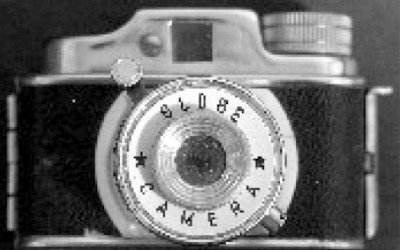
-- a hard-to-find "HIT"-type camera, it is almost always seen in a gold-plated body with an Art Deco appearance. And if you really want to find an even-harder-to-find "HIT"-type camera, track down the GNCO in a CHROME BODY.
-- a "HIT"-type camera
-- a "HIT"-type camera
-- HAM it up with this typical "HIT"-type camera.
-- a "HIT"-type camera made by -- you guessed it -- Tougodo!
-- a "HIT"-type camera
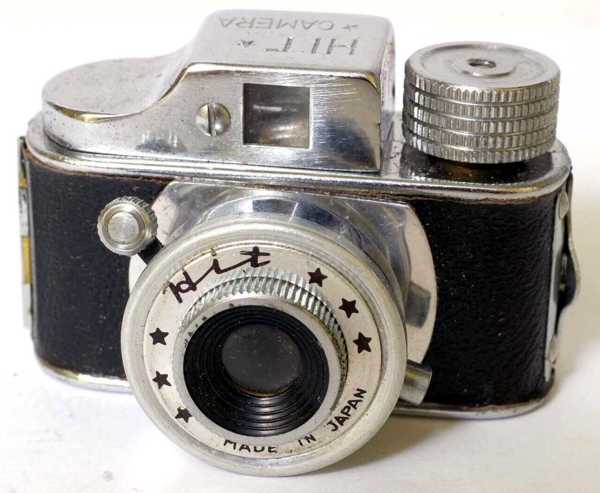
Most of the cameras on this page are referred to as "Hit cameras", but they really aren't Hit cameras because their label is not marked "HIT". But there are actually several types of the original HIT cameras -- that are marked "HIT". The first appeared shortly after the War ended. It had a fixed-focus 30mm lens, a single speed of 1/30, and a fixed aperture of f11. Later versions of the genuine Hit camera had slight variations in the front nameplate of the camera, the shape of the body and film advance knob, the leatherette color, and most had two shutter speeds -- I (1/25) and B. There was even a "gold" version made. All of the genuine "Hit" cameras were made by the Tougodo Co., that was founded in 1930, and had several factories operating by the time the War began. They are well-known for their 35mm cameras with names such as Toyoca, Meisupi and Meikai. By the end of the War, only a couple of factories remained, and the Tougodo Company produced the first HIT camera around 1947. Later, it also make many other Hit-type cameras with different labels, such as the ARROW, C.M.C., CLICK, EMSON, SATILLITE, SPEEDEX, and TRAVELLER cameras (above & below). Still, the Hit look-a-likes were mostly made by other firms and had different names, as you can see on this list. The actual name "HIT" probably comes from an older camera that Tougodo Co. made in the 1930's -- before the war. It was a standard box camera that took 35 x 55mm images -- and was named the "HIT-GO".
-- the best known "HIT"-type camera. It has lots of variations over time, but all are clearly marked "HIT". See also "Hit-II" and "New Hit"
-- It looks so different, it might have been made by a different company. In any case, it is a LOT harder to find than the original Hit camera.
-- Hit wasn't the only brand that added the word "Foreign" to its lens plate. See Marvel & Minetta (below).
-- (1960) Shaped just like the Olympus Pen 35mm half-frame camera of 1959, the Honey was an attempt to ride the Pen's coattails. Otherwise, the features are similar to a very basic Hit-type camera with a fixed-focus, unmarked lens, with a single shutter speed. Perhaps if the Mascot Camera Works had named it the PENey, it might have been a HIT.
-- see Sugaya
-- a "HIT"-type camera made by -- you guessed it -- Tougodo -- but can you guess what "I.G.B." means?
-- a "HIT"-type camera that, as far asa we can determine, has no relation to the Vice President of the United States.
-- (1949) While most 17.5mm cameras are horizontally styled, some had a vertical style with the film running up & down. Of course that makes no difference with a square film format. Some were TLR cameras, and operated like them,.but the Jenic was styled like a movie camera -- and operated like one, as well. It has a fixed-focus 35mm 2.8-11.0 lens and a shutter with speeds of B, 1/20, 1/50, 1/100 & 1/200. A fixed viewfinder is on the top, and the film is advanced with a lever with the shutter release right under your thumb.
-- a "HIT"-type camera
-- a "HIT"-type camera
-- a "HIT"-type camera
see Morita Kiku 16
-- a "HIT"-type camera
-- a "HIT"-type camera
-- a typical "HIT"-type camera, but hard to find. It's the same as the Q.P. (see below) -- which is much EASIER to find. Not to be confused with the numerous Hello Kitty cameras -- one of which used 110 film.
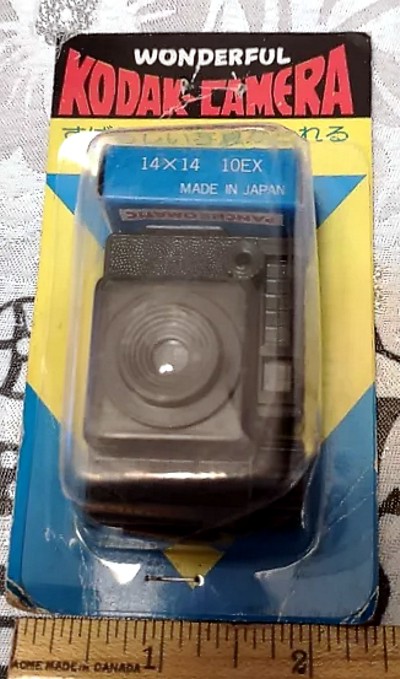
It's not made by Kodak, but it's "WONDERFUL" anyway -- and it uses 17.5mm film. I guess the REAL Kodak didn't think it was worth taking them to court.
-- see Okako
-- see Snappy
-- It's probably just the Corona
-- see Toyoca KUTE
-- see Lovely
-- a "HIT"-type camera
-- a "HIT"-type camera
-- (1948) Fixed-focus lens in a rectangular body, similar to the Robin (below). Speeds of B, 1/25 - 1/100. Hard to find.
They were hoping that the name would sell the camera, because the features won't -- it's a standard Hit-type camera. Â Speeds of B and I (1/50). Looks the same as the Happy (above). Perhaps the two should have been combined and sold as the HAPPY-GO-LUCKY.
-- a "HIT"-type camera. Fixed-focus, fixed f-stop lens. Two shutter speeds -- I and B.
-- a "HIT"-type camera
-- One of at least three "HIT"-type cameras that used the "Foreign" name -- see "Hit Foreign" and "Minetta Foreign".
-- see Shimura
-- (1950) Due to the similarity, it was probably made by the same factory as the Peace camera (below). Fixed-focus, 20mm f3.5 lens. Speeds of B and I. Round viewfinder on top. Was it named after that famous Mouse? Curious minds want to know!
-- a "HIT"-type camera. See also Mighty Midget, and Misuzu Midget.
-- see Mity, Toko Mighty, or Mighty Midget.
-- a "HIT"-type camera
-- a "HIT"-type camera. Like the CMC camera (above -- and other Hit-style cameras), the Minetta came with different names on the face-plate, and different colored leatherette. This model is marked "MINETTA" on the top of the lens, and "MADE IN JAPAN" on the bottom.
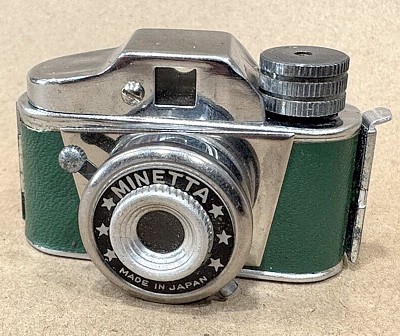
-- a "HIT"-type camera. This model is marked "MINETTA" on the top of the lens, and "CAMERA" on the bottom.
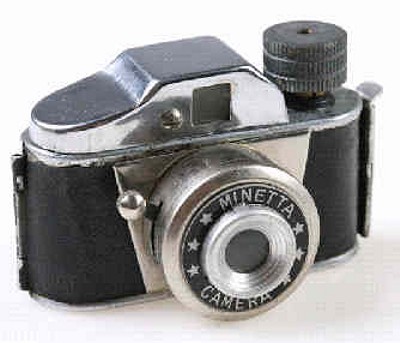
-- a "HIT"-type camera. This model is marked "MINETTA" on the top of the lens, and "FOREIGN" on the bottom.
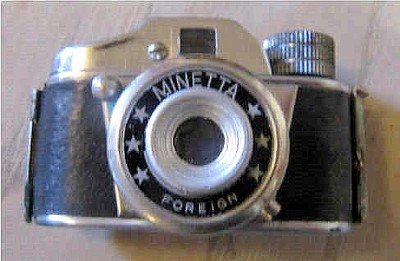
-- (1950) A vertically-styled camera with a fixed-focus lens. So it's definitely NOT a "HIT"-type camera! Plus it has shutter speeds of B, 1/25 - 1/150. Pop-up viewfinder on the top. think of it as a poor man's 17.5mm Steky. Not to be confused with the Mini Camera (below)
-- see Sing 388 and Laurie Import
-- see Okako
-- a "HIT"-type camera
-- a "HIT"-type camera -- and available in several colors.
-- a rarely seen "HIT"-type camera. See also Mighty (above).
-- see Sanwa Mycro
-- a "HIT"-type camera. It has the name of the U.S. distributor -- SOUTHERN -- on the frontplate.
-- (1950) Two models exist. Both have a fixed-focus (f4.5) lens. One model has a variable aperture to f11.0. The other is fixed at f4.5. Both have speeds of B, 1/25 - 1/100.
-- a "HIT"-type camera. In fact, it's exactly like the original Hit camera, and made by Tougodo. It is simply marked "HIT" on the lens plate, but the top of the viewfinder is marked "NEW HIT".
-- (1950) An improved Hit-type camera with a faster, fixed-focus 20mm fixed f4.5 lens. Speeds of B and I. The lens face plate is marked "ROCKET", but the finder housing is marked "NEW ROCKET". It has been seen with different faceplates, and even a "gold" version. See also ROCKET CAMERA (below) to which it may or may not be related.
-- might just be a misunderstanding
-- Like the New Rocket (above), the Ogica is a step up from the typical "HIT"-type camera. It sports a fast f4.5 Ogikor Anast. lens. Very hard to find.
-- see Okako
-- a "HIT"-type camera -- not to be confused with "Souvenir of Mexico" (below).
-- a "HIT"-type camera made by -- you guessed it -- Tougodo!
-- a "HIT"-type camera
-- just another "HIT"-type camera. The box says "PAMEX BABY CAMERA".
-- (1949) Fixed-focus 20mm lens. Speeds of B and I. Round viewfinder on top.
-- (1950) Fixed-focus 20mm (fixed f4.5) lens. Speeds of B and I. Round viewfinder on top. Was there a Peace II? Curious minds want to know!
-- (1950) This is a tiny twin lens reflex (TLR) camera with pop-up viewfinder. Fixed-focus 20mm f3.5-11.0 lens. Speeds of B and I. Probably a later version of the Baby Flex (above). Also sold as the Peace Small Lef and the Sholy-Flex cameras (below).
-- (1950) This is a tiny twin lens reflex (TLR) camera with pop-up viewfinder. Fixed-focus 20mm f3.5-11.0 lens. Speeds of B and I. Probably a later version of the Baby Flex (above). Also sold as the Peace Baby Flex (above) and the Sholy-Flex camera (below).
-- (1950) This is a tiny box camera with pop-up sportfinder and regular viewfinder. Fixed-focus (fixed f4.5) lens. Speeds of B and I.
-- (1955) Fixed-focus lens with two f-stops marked with images of "clouds" and "sun". Single speed.
-- (1950) Round camera, sort of like the Petal, but the lens points out the top. Fixed-focus 25mm (f8.0) lens. Speeds of B and I. Pop-up viewfinder on the side.
-- a "HIT"-type camera
-- a "HIT"-type camera. Like many Hit-type cameras it has appeared with slightly variations. It is marked "Prince" on the lens and can be marked "Prince-S" on the top, "16-S" on the lens, etc.
-- (1960) Unusual bar-type 17.5mm camera with a fixed-focus (f10.0) lens. Like other Hit-type cameras, it has two speeds -- B and I. It is also notable for its imitation selenium meter, and unusual, but larger, 14x16mm film format size. It is marked "Prince" on the front and "Prince 16-A" on the case.
-- It's the same as the Homer 16 (above) and the Toyoca Ace (below) -- including the fake meter next to the viewfinder -- but unlike the other cameras, it came in various colored leatherettes, such as black, silver, or gold. Talk about CLASS! It is marked "Prince" next to the viewfinder, and "Prince Ruby" on the lens.
(1960) Fixed-focus lens. Speeds of B and I. A "HIT"-type camera. Same as the Kitty (see above).
-- a "HIT"-type camera
-- Did it "REAL"ly exist?
-- a "HIT"-type camera -- made by Tougodo -- and seen with slightly different film advance knobs.
-- (1950) A bar-style camera with a flip-up front cover to protect the lens and viewfinder. Similar to the Lovely (above). Fixed-focus lens. Speeds of 1/50 - 1/100.
-- a typical "HIT"-type camera. It is marked "ROCKET CAMERA" on the lens front plate. Also see New Rocket (above) to which it may or may not be related.
-- see Sugaya
-- see Sugaya
-- see Morita Saika
-- see Toyoca
-- a "HIT"-type camera made by -- you guessed it -- Tougodo!
-- see Harukawa
-- another "HIT"-type camera from Tougodo. Typical fixed-focus, fixed f-stop lens and two shutter speeds -- I and B.
-- a hard-to-find "HIT"-type camera
-- (1950) An extremely rare vertically-styled 17.5mm camera apparently produced by the Shimura Co. under the authority of Topcon. Not much is known about it, and if any were actually produced -- a big "IF" -- it might have appeared in different varieties, such as a 20mm or 25mm lens, both with two aperture settings -- f4.5 & f8. The lens is fixed-focus, of course, with shutter speeds of B, 1/25, 1/50, & 1/100 -- both selected by small levers on the front. Looking much like the 16mm Coronet Midget -- not the Mighty Midget or Misusu Midget -- it has a built-in viewfinder on the top.
-- (1950) This is a tiny twin lens reflex (TLR) camera with a pop-up viewfinder. Fixed-focus 20mm f3.5-11.0 lens. Speeds of B and I. Probably a later version of the Baby Flex (above). Also sold as the Peace Small Lef and the Peace Baby Flex cameras (above).
-- see Gemflex
-- a "HIT"-type camera
-- The Sing 88 stands out because it is shaped more like a "Bell 14" (see above), mini-rangefinder-style camera, than a typical "HIT"-style camera -- even though the simple features are the same. Like its brother (below) it is marked "MINI CAMERA" on the front of the lens, but unlike it's brother, it is also marked "Sing 88" on the front of the camera.
-- A typical "HIT"-style camera but unlike its sister (above) the camera is simply marked "MINI CAMERA" on the lens face, and only the box indicates a different name -- "Sing 388".
-- a "HIT"-type camera
-- a "HIT"-type camera -- not to be confused with "Old Mexico" (above).
-- These are the initials of the manufacturing company that are stamped on the bottom of the Sun B camera (below).
-- see Mykro-fine
-- a "HIT"-type camera made by -- you guessed it -- Tougodo! It should not be confused with the much larger Speedex cameras from Agfa and Ansco that used 120 film.
-- a "HIT"-type camera
-- a "HIT"-type camera that should not be confused with the much larger Sputnik camera from the Soviet Union that was a stereo TLR (TRIPLE Lens Reflex) camera using 120 film.
-- see Maruso
-- a "HIT"-type camera in a slighty more "sophisticated" body -- not to be confused with the more pedestrian, "cosmic", Hit-cameras like: Sun, Astra, Blue Star, Comex, Sputnik, Rocket, Globe, Star-Lite, Stellar, etc.
-- a "HIT"-type camera. "Lite" might be in the name, but it weighs the same as any Hit-type camera.
-- yet another celestial "HIT"-type camera -- without any stellar features.
-- Wouldn't it be nice to have a stereo "HIT-type" camera? What would that be, exactly? A Hit camera with two speakers that plays music? Don't be ridiculous! Actually there is a Stereo Hit camera, but it doesn't have speakers and it doesn't play music. And it doesn't use 17.5mm film. It uses 127 film and takes TWO pictures to create 3-D images. Why they named it the "STEREO HIT" camera instead of the "3-D 127" camera might be the reason it was a complete failure. People were expecting MUSIC!!!
-- another "HIT"-type camera from Tougodo (see below)
-- There were two cameras that carried the Swallow name -- kinda, sorta -- but they are very different in features, even though they are from the same era -- late '40s to the early 50's. The most common is this slightly elongated "HIT"-type camera with the typical features. Two speeds of B and I (1/50) with a fixed-focus, single aperture lens, probably f11. I know it's hard to swallow, but a more upscale "Swallow" was also made -- see Tsubame (below).
-- (1955) Camera was shaped like a small Leica. Fixed-focus 30mm (f8.0) lens. Speeds of B, 1/25 - 1/100. Flash synch.
-- (1950) Several 17.5mm cameras appeared in different colored leatherette or metal. Some were made with different film winding knobs of viewfinders. The Takka was made with two different top plates, but otherwise were the same. They had a fixed-focus 20mm lens and speeds of B, 1/25 - 1/50. Except for the variable shutter speed they were your typical "HIT"-type camera. One model had a curved top plate, while the other had a "stepped" top plate.
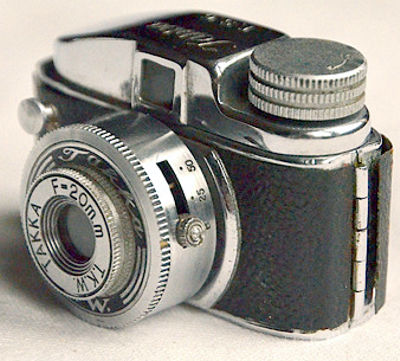
-- a "HIT"-type camera
-- a "HIT"-type camera
-- a "HIT"-type camera
-- a "HIT"-type camera
-- (1947) 25mm (f4.5-8.0) fixed-focus lens. Speeds of B and I. A "HIT"-type camera with a few of improvements. First, there is the waist-level finder built-in, right next to the regular viewfinder. Even more important is the variable aperture, which improves results when stopped down, and offers some exposure control. In addition, a lens shade and a 2X teleconverter was made which slipped onto the front of the lens.
-- See Rubix.
-- See Maruso
-- Tougodo made the first camera with the "HIT" name. It was made in the 1930's -- before the War. It was a standard-looking box camera that created 35mm x 55mm images -- and was named the "HIT-GO" because it used special paper that you could develop without a darkroom! After the War, in 1947, they introdued the more commonly known "HIT" camera using 17.5mm film (see above). Later they created many other 17.5mm cameras (see the individual cameras for details) -- such as the Amerex, Arrow, Astrophic, Baby Flex, Baby Max, Barlux, Beica, C.M.C., Click, Colly, Diplomat, Emson, Global, Happy Hit, Homer, I.G.B., Kute, Minetta, Mini Camera, P.A.C., Regent, Satellite, Shalco, Speedex, Sterling, Sweet 16 A, Toyoca, Toyoca 16, Traveller, U.P., Walklenz, and probably others. It seems they couldn't run out of names -- although many of them are actually the same camera.
-- see Mighty and Tone
-- a "HIT"-type camera, made by -- you guessed it -- Tougodo!
-- see Tacker
-- an early, rare "HIT-type" camera, which means "Swallow", and should not be confused with the other "HIT-type" Swallow camera (above). This model is more versatile with a faster, fixed-focus, 20mm f4.5-9.0 lens and variable speeds from 1/25 - 1/100, plus B. In addition, this "Swallow" lacks the typical "HIT"-type viewfinder, and has a waist-level finder instead.
-- see Ginrei Vesta
-- a "HIT"-type camera
-- an infrequently found "HIT"-type camera, made by -- you guessed it -- Tougodo!
-- see Kodak-Camera
-- see Halmat

To return to the main index for the Sub Club click here.
COPYRIGHT @ 1995-2025 by Joe McGloin. All Rights Reserved.